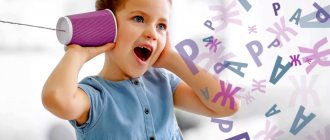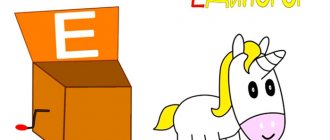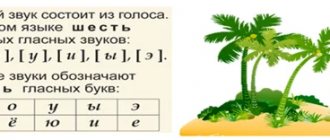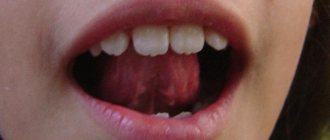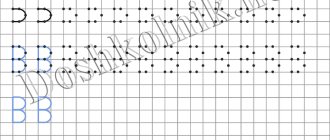Summary of a speech therapy lesson in the senior group for children with special needs: Sound B
Speech therapy lesson for older preschoolers of a preschool educational institution
The lesson is designed for preschool children, and includes not only the use of corrective games aimed at developing clear, expressive speech in children with an age-appropriate vocabulary. This lesson also includes games and exercises to develop the skills of sound analysis and synthesis, phonemic perception. The content of the lesson is designed taking into account the leading activities of preschoolers. Topic “Sound [b]” Correctional and educational goals. Consolidating the correct pronunciation of the sound [b]. Formation of skills in sound analysis and word synthesis. Dividing words into syllables. Corrective and developmental goals. Development of phonemic perception, attention, speech breathing, general motor skills, coordination of speech with movement. Correctional and educational goals. Formation of mutual understanding, independence, goodwill, initiative, responsibility. Equipment: object pictures for sound [b], blue ribbons and massage balls according to the number of children, tape recorder, CD, dog toy, “magic” flower, stickers for each child.
Move
1. Organizational moment (children stand in a circle). Greetings. Children pass each other a “magic” flower and greet each other: “hello, smart Alina,” “hello, kind Yaroslav,” etc. Self-massage of the face and neck (performed to the musical composition “Morning” by Edvard Grieg). We use the warmth of our palms (Rub our palms.) Relax the whole face, (Run our palms in front of our faces.) And then, learning from cats, (Stroke the face from top to bottom. Make a ring, right and left.) We stroke the forehead, knead, (Stroke and knead forehead.) We pinch the eyebrows, and then (We pinch the eyebrows.) We run to the cheeks - (We move our fingers to the cheeks.) We stroke them, knead them. (We stroke and knead the cheeks.) We pinch, we pinch (We pinch the cheeks.) And we remember them in a circle, (We do a circular kneading of the cheeks.) And then we press (We press with our fingers on the muscles of the cheeks.) And we shake a little. (We lightly shake our cheeks with our fingers.) Like water from a faucet, (We stroke the nasolabial folds. We flow straight down, from top to bottom.) A particle of the feather circles (We make spiral movements downward. The wind of the capricious young man along the nasolabial folds.) We stroke the upper sponge (We stroke the upper lip. ) And we’ll pinch and remember. (We pinch and knead the upper lip.) And we move on to the lower lip - (We stroke the lower lip.) We also pinch, we also knead. (We pinch and knead the lower lip.) And then we put them together, (We connect the lips extended forward.) To pinch both, (We knead both lips.) And then at this place we will tap our fingers. (We do a finger shower for the lips.) We iron the lips. Under the lips (Stroke the lips.) We begin to knead. (We knead the chin.) You and I would like a chin (Rub the chin between our fingers.) Pull back and knock. (We tap with our fingers.) And we pinch directly to the lobes, (We pinch the lower jaw.) And then with the whole palm (We stroke the neck from top to bottom, open. Down the neck - with a wire - with the palm with the thumb extended. We flow down like a stream. finger.) Development exercise speech breathing. Rise on your toes – inhale through your nose, lower – exhale through your mouth. Speech therapist: Let's breathe in all the good things - joy, health; Let's breathe out all the bad things - sadness, anger. Children go to their desks. 2. Introduction to the topic. A toy dog is on display. Speech therapist: Buska came to visit us. He wants to study sounds with us. What is the first sound in the nickname Buska? (Sound [b]). Pronunciation, characteristics of the sound [b]: articulation (when pronouncing the sound [b], the lips are tightly compressed, the tongue lies calmly in the mouth, the air stream is fast). Speech therapist: Is the sound [b] a vowel or a consonant? Children: Consonant, it cannot be sung or drawn out. Speech therapist: Put your hand to the neck and determine how we pronounce the sound [b] - with or without a voice? Children: With a voice, that means the sound [b] is sonorous. Speech therapist: Bend your fingers and repeat what sound [b]. Children: Consonant, voiced. Speech therapist: What color circle will we use to denote the sound [b]? Children: Blue. 3. Game “Wave the Ribbon”. The speech therapist distributes ribbons to children. Speech therapist: Take the ribbons in your hands. Wave them as soon as you hear the sound [b]: - among a series of sounds: b, n, p, b, m... - among the syllables: ba, ma, but, bo, would, well, in, would... - among the words: banana, bun, window, jar…. Speech therapist: Well done! You were attentive. The speech therapist removes the ribbons. 4. Selection of pictures for sound [b] Speech therapist: Buska brought pictures and asks him to help him choose pictures with sound [b]. Children take turns approaching the speech therapist and choosing pictures. 5. Physical exercise “The giraffe has spots” (CD is turned on). Movements are performed in accordance with the text. 6. Dividing words into parts Speech therapist: The word is divided into parts. Oh, what happiness this is! Every literate person can make a word from parts. Let's help Buska determine how many parts there are in the names of the pictures. (Children slap the words). 7. Introducing the letter B. Speech therapist: It’s time to get acquainted with the letter that denotes the sound [b]. B – a large barrel with a tap, We drink from the barrel early in the morning. (V. Kovshikov) What else does the letter B look like? 8. Game “Don’t rush, don’t rush, speak - don’t make a mistake” Speech therapist: Now let’s play the game “Don’t rush, don’t rush, speak - don’t make a mistake.” If only there were oak trees in the clearing. Boo-boo-boo - a woodpecker is sitting on an oak tree. (Children repeat in chorus, in rows). 9. Playing with “Hedgehog” massage balls Speech therapist: Buska invites us to play with massage balls that look like hedgehogs. Hedgehog, hedgehog, prickly ball, How tenacious you are! I rock you, rock you - I want to reveal everything to you. (We roll the ball in our hands.) The hedgehog wrapped its needles (We clasp the ball one by one with our palms.) And, probably, fell asleep. I’ll put you down and get some sleep, accumulate strength for the winter. (Collect balls in a basket.) 10. Game “Say a word” Speech therapist: In the game “Say a word” you need to add a word! On land and under water From Arkashka's pockets He is looking for a golden key, Bugs are always falling... (smears) He pokes his long nose everywhere Who is it? (Pinocchio) There is not a bird on the branch - the animal is not big. The fur is warm, like a hot water bottle. Who is this? (Belka) 11. Selection of words with the sound [b] Speech therapist: Well, now let’s give Buska words that begin with the sound [b]. (Children pass the “magic” flower and name the words). 12. Summary Speech therapist: What sound did we meet today? — Name the games that you liked. - Well done! You completed all the tasks and helped Buska. The speech therapist gives the children stickers for their notebooks. Used literature 1. Agranovich Z.E. To help speech therapists and parents. A collection of homework to overcome the underdevelopment of the phonemic aspect of speech in older preschoolers. – SPb.: DETSTVO-PRESS, 2004. – 160 p. 2. Krupenchuk O.I. A comprehensive technique for correcting violations of the syllabic structure of words. – St. Petersburg: Litera, 2013. – 96 p. 3. Krupenchuk O.I. Graphomotor tasks for left-handers // Speech therapist. – 2012. – No. 6. – P. 95-103. 4. Nishcheva N.V. Notes of subgroup speech therapy classes in the senior group of kindergarten for children with special needs development. – SPb.: DETSTVO-PRESS 2007. – 704 p. 5. Pyatibratova N.V. Speech therapy classes with elements of the Montessori method. – M.: TC Sfera, 2010. – 112 p. 6. Smirnova L.N. Speech therapy in kindergarten. Classes with children 5-6 years old with general speech underdevelopment: A manual for speech therapists, defectologists and educators. – M.: Mozaika-Sintez, 2004. – 77 p.
We recommend watching:
Summary of an individual educational activity with a 5-6-year-old pupil for the correction of sound pronunciation. Notes of an educational activity in a senior speech therapy group. Notes of a lesson in a senior speech therapy group. Notes of an individual correctional and developmental speech therapy lesson. Senior group
Similar articles:
Summary of educational activities in the older group of children with severe speech impairments on the topic: “Sounds S - Z”
Summary of educational activities in the senior group of children with severe speech impairments on the topic: “Sounds S - Sh”
Summary of a subgroup GCD to eliminate disturbances in sound pronunciation in children of the older group with severe speech impairments
Summary of educational activities in the senior speech therapy group on the topic “Cossacks and their traditions”
Logorhythmic lesson for children of senior preschool age with special needs on the topic: “What types of transport are there?”

